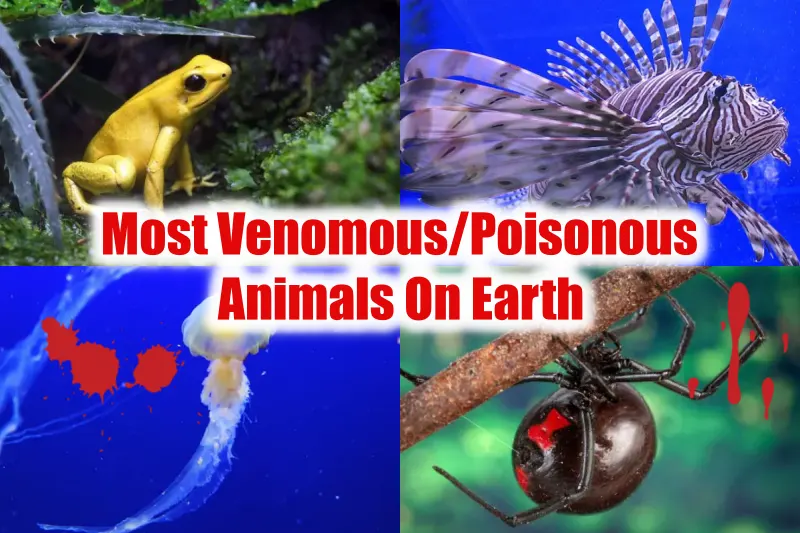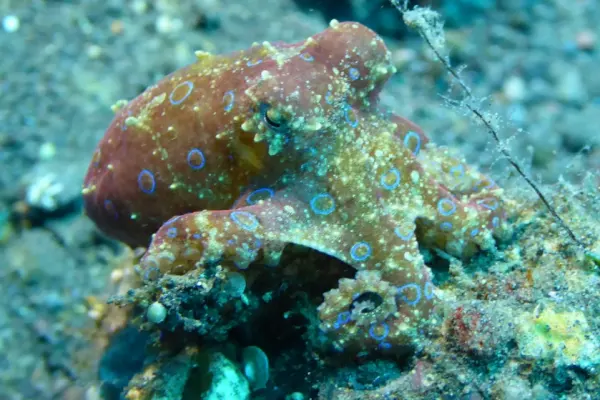Even if you love the outdoors, there are always marvels you should only see from a distance. Among these wonders are the enthralling—or occasionally terrifying—poisonous animals that can endanger your life while you’re just having fun.
Thus, we have compiled a list of the Top 50 most Venomous/Poisonous Animals On Earth that you should steer clear of at all costs. However, some also happen to be so fascinating that you will find yourself reading articles about them nonstop. So without further ado, let’s get going. Have fun scrolling!
Most Poisonous Animals Underwater
1. Australian Box Jellyfish
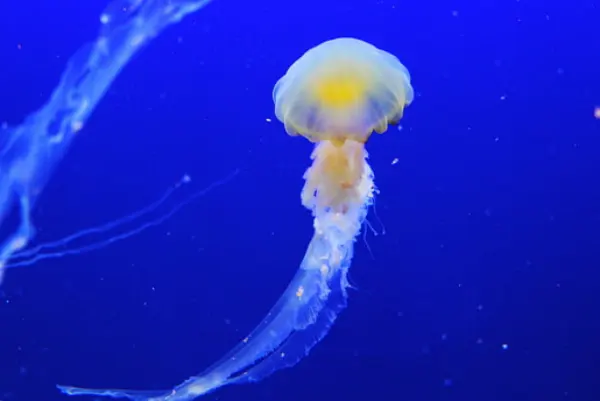
- Scientific name – Chironex fleckeri
- Size – 16 to 35 cm
- Habitat – Coastal waters of New Guinea, northern Australia, Singapore, Indonesia, Malaysia, Cambodia, the Philippines, and Vietnam
- Toxicity Level – cause death as quickly as 3-5 minutes
- Estimated no. of Deaths in a Year – 50 to 100
The Australian Box Jellyfish or sea wasps, have the fastest-acting poison on Earth. It’s not the strongest poison available, though. However, running across one of these guys could be your worst nightmare, as you could die within 15 minutes after the encounter.
It’s all because of the Nematocysts that they are covered with. These are little venom-filled darts that release heart-stopping poisons wherever they come into contact with the body.
2. Stonefish – Synanceia verrucosa
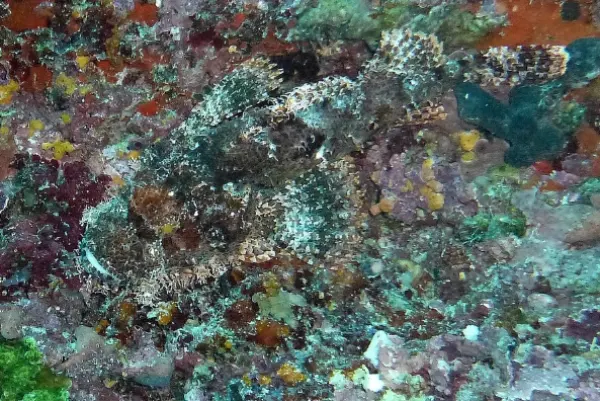
- Scientific name – Synanceia verrucosa
- Size – 27 to 40 cm
- Habitat – shallow tropical marine waters in the western Pacific Ocean, Indian Ocean, Red Sea, coastal East Africa, French Polynesia, southern Japan, and surrounding Taiwan
- Toxicity Level – Can be fatal at a dose of only 18mg
- Estimated no. of Deaths in a Year – No data available
The proteinaceous toxin verrucotoxin (VTX) is the potent venom of stonefish, which remains in its dorsal fine spines.
Intense pain, respiratory weakness, necrosis, hemorrhage, damage to the cardiovascular system, convulsions, paralysis, and occasionally even death is possible with its sting.
With only six of its thirteen spines, the stonefish may release venom that is lethal at doses as little as 18 mg. It is sometimes called the most venomous fish in the world.
3. Blue-Ringed Octopus
- Genus – Hapalochlaena
- Size – 4 to 12 cm including its arms
- Habitat – Coral reefs and rocky regions of the bottom, while some can also be found in tide pools, seagrass, and algal beds.
- Toxicity Level – 1,000 times more toxic than cyanide
- Estimated no. of Deaths in a Year – 7 to 16 deaths
Blue-ringed octopus venom may kill a human in 20–40 minutes as it is 1,000 times more lethal than cyanide.
Its saliva contains bacteria that produce a very strong neurotoxin that paralyzes your muscles. You will be dead from asphyxia in a matter of minutes after that paralysis affects your ribs and diaphragm.
4. Pufferfish (Fugu)
- Scientific name – Takifugu rubripes
- Size – up to 6 cm
- Habitat –Tropical and subtropical ocean waters
- Toxicity Level – contain dangerous nerve toxins
- Estimated no. of Deaths in a Year – 2 to 6 approx.
This fish contains tetrodotoxin, a strong neurotoxin, even though it is not venomous in the traditional sense. Inadequate preparation can result in death or paralysis from consumption.
The pufferfish’s spikes, liver, and kidneys are home to harmful nerve poisons that are lethal to humans.
5. Striated Surgeonfish
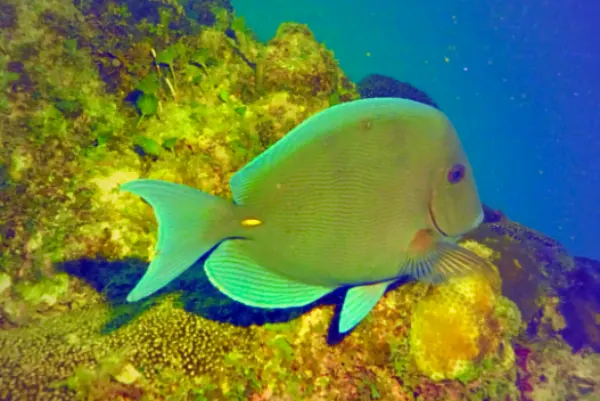
- Scientific name – Ctenochaetus striatus
- Size – 18 to 26 cm
- Habitat – Inhabits seaward reefs, lagoons, and reef flats down to a depth of more than 30 meters
- Toxicity Level – It accumulates toxins through its diet
- Estimated no. of Deaths in a Year – causes poisoning to around 20,000 to 50,000 people each year
Through its food, a striated surgeonfish accumulates toxins. They occasionally eat microscopic dinoflagellates that create maitotoxin when they are grazing on algae.
Every year, 20,000 to 50,000 people suffer from ciguatera fish poisoning due to the accumulation of this toxin in their flesh.
6. Comb Starfish
- Scientific name – Astropecten polyacanthus
- Size – up to 20 cm
- Habitat – Shallow tropical and sub-tropical seas throughout the Indo-Pacific region from Red Sea, Zanzibar, and Hawaii Also Japan, Australia, and New Zealand
- Toxicity Level – a potent neurotoxin that can cause paralysis and eventual death from respiratory failure
- Estimated no. of Deaths in a Year –No data available
Comb starfish are capable of paralyzing victims and finally killing them from respiratory failure due to the strong neurotoxin, Tetrodotoxin, they contain.
This toxin can kill 520 mice per gram, and as in the present scenario, there is no known antidote for tetrodotoxin.
7. Geography Cone Snail
- Scientific name – Conus geographus
- Size – 10 to 16 cm
- Habitat – reefs of the tropical Indo-Pacific
- Toxicity Level – Even one sting is potent enough to kill 15 humans
- Estimated no. of Deaths in a Year – As much as 700 deaths have been recorded over the years
They appear to be simple, conical shells at first glance. However, they have a harpoon attached to a venom gland—that they employ to hunt and protect themselves, and in certain cases, even kill humans.
The geographic cone is a marine predator that goes by the term “cigarette snail” because of its powerful 200-ton toxin cocktail. If you get stung by one of these creatures, you can only grab a chance to smoke a cigarette before you die.
The second hidden weapon of this cone snail is that it stuns fish before attacking them by shooting a fog of insulin out of its mouth.
8. Marbled Cone Snail
- Scientific name – Conus marmoreus
- Size – around 2 to 3 inches
- Habitat – Coral reef terraces and sandy ocean bottoms
- Toxicity Level – affects the nervous system and is capable of causing paralysis, highly potent
- Estimated no. of Deaths in a Year – No data available
This creature’s venom is strong enough to kill twenty adult humans with just one drop. This species predominantly eats marine mollusks, such as other cone snails.
9. Hawksbill Sea Turtles
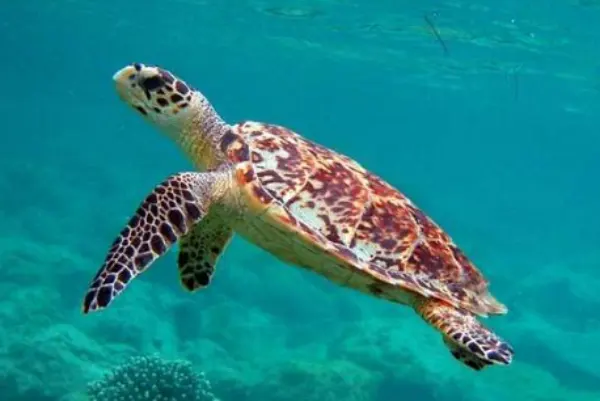
- Scientific name – Eretmochelys imbricata
- Size – around 2 to 3 feet
- Habitat –Oceanic tropical and sub-tropical waters
- Toxicity Level – causes severe poisoning as its flesh can become venomous through its diet
- Estimated no. of Deaths in a Year – No data available
The flesh of hawksbill sea turtles can become extremely toxic due to their diet, which includes venomous cnidarians and a range of toxic algae and sponges.
This implies that anyone consuming the meat of one of these turtles runs the risk of developing poisoning, which involves vomiting, diarrhea, and other gastrointestinal issues.
10. Giant Mushroom Anemone
- Scientific name – Rhodactis howesii
- Size – around 2 to 3 feet
- Habitat – Inhabits reef slopes and reef shallows
- Toxicity Level – can cause severe poisoning and eventual death due to prolonged effects
- Estimated no. of Deaths in a Year – No data available
This is the world’s most toxic sea anemone. To make comment on its toxicity – shortly after consumption, the poisoning symptoms manifest as an anesthesia-like coma with pupillary dilatation and the lack of involuntary motor reflexes.
Blood pressure and heart rate remain normal throughout this period, but after 8 to 36 hours in this state, people go into shock and die from pulmonary edema. Thus, we can deduce that severe poisoning eventually results in death.
11. Portuguese Man O’ War
- Scientific name – Physalia physalis
- Size – float can be up to 6 inches (15 cm) tall while the tentacles grow as long as 50 m
- Habitat – Found in the Indian, Pacific, Atlantic, and Caribbean oceans, but also in warmer tropical and subtropical waters
- Toxicity Level – causes cardiotoxicity and abnormality in ionic transport across membranes
- Estimated no. of Deaths in a Year – No data available
Many people mistake these jellyfish-like aquatic poisonous animals for jellyfish because of their colonial bodies, floating lifestyles, and potent stings.
Portuguese man-of-war stings are common, extremely painful, and can cause dangerous side effects like fever, shock, and disruption of heart and lung function. The stings leave victims with red welts and blisters.
Although they are uncommon, Portuguese man-of-war sting deaths have been documented.
12. Hell’s Fire Anemone
- Scientific name – Actinodendron arboreum
- Size – 10 to 20 cm
- Habitat – Indo-pacific waters
- Toxicity Level – severe blisters can occur from its sting and eventual death too (upon consumption)
- Estimated no. of Deaths in a Year – No data available
Actinodendron arboreum is known as “hell’s fire anemone” due to its extremely poisonous nature, which can result in severe blisters from its sting. In fact, ingesting it can cause grave belly and intestinal ulcers, which can ultimately lead to death.
13. Night Anemone
- Scientific name – Phyllodiscus semoni
- Size – 10 to 20 cm
- Habitat – shallow seas in the central Indo-West Pacific
- Toxicity Level – painful, long-lasting sting that can cause renal failure
- Estimated no. of Deaths in a Year – No data available
When Phyllodiscus semoni comes into contact with humans, it can result in severe dermatitis that swells and ulcerates the affected area and can last for months. Phyllodiscus semoni has many hemolytic toxins, and its venom can cause acute renal failure by damaging the kidneys.
14. Haeckel’s Sea Anemone
- Scientific name – Actinostephanus haeckeli
- Size – about 10 to 12 cm in diameter
- Habitat – sandy bays, lagoons and bottoms
- Toxicity Level – painful, long-lasting sting that can cause blisters
- Estimated no. of Deaths in a Year – No data available
This strange-looking anemone is one of the extremely poisonous animals. And if its bite is not treated, the results can be long-lasting and include severe blisters and scars.
15. Striped Pyjama Squid
- Scientific name – Sepioloidea lineolata
- Size – about 7 to 8 cm
- Habitat – Indo-Pacific Oceans of Australia
- Toxicity Level – neurotoxic
- Estimated no. of Deaths in a Year – No data available
Beneath their bodies, Sepioloidea lineolata possess glands that can create a deadly slime that is loaded with various proteins and poisons. Its saliva contains tetrodotoxin, one of the most potent neurotoxins that is capable of killing a person.
16. Nudibranch
- Scientific name – Nudibranchia
- Size – up to 45 cm
- Habitat – sandy bays, lagoons and bottoms
- Toxicity Level – painful but not fatal
- Estimated no. of Deaths in a Year – No data available
One of the very poisonous animals, nudibranchs consume the stinging cells of hydrozoids and store them in the back of their bodies for defense. They may also absorb poisons from sponges, turning them poisonous and unfit for consumption.
17. Boxfish
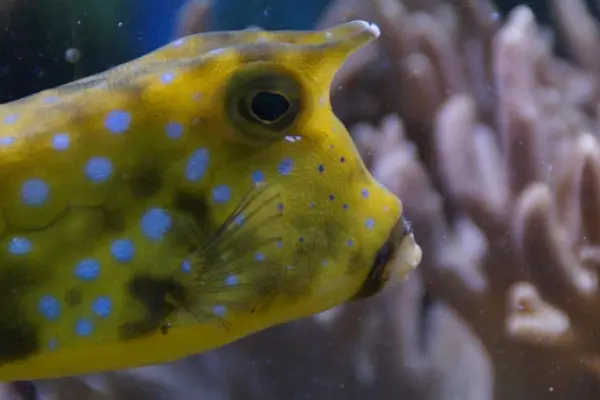
- Scientific name – Ostracion cubicus
- Size – 3 to 16 inches
- Habitat – Indo-Pacific regions
- Toxicity Level – food poisoning, irritation, and dizziness, plus renal effect is also possible upon bite
- Estimated no. of Deaths in a Year – No data available
Although boxfish can produce their own toxins to ward off predators, they are able to release toxic mucus through their skin rather than storing these toxins in their bodies. This poison, which is classified as an Ostracitoxin, explodes red blood cells due to its hemolytic impact.
18. Flamboyant Cuttlefish
- Scientific name – Metasepia pfefferi
- Size – about 6 to 8 cm
- Habitat – Indian and Pacific Oceans
- Toxicity Level – highly poisonous, as lethal as the blue-ringed octopus’s bite
- Estimated no. of Deaths in a Year – No data available
Flamboyant cuttlefish are only the third known cephalopod to be poisonous due to their highly toxic muscle tissue. Its poison is just as deadly as that of the blue-ringed octopus. But they rarely encounter humans, so no fatalities are recorded.
19. Irukandji Jellyfish
- Scientific name – Carukia barnesi
- Size – bell is about 5 to 25 mm in diameter with approx. 1 m long tentacles
- Habitat – deep offshore waters of northern Australia
- Toxicity Level – can cause deadly brain hemorrhages
- Estimated no. of Deaths in a Year –50-100 people get hospitalized annually
Irukandji jellyfish are capable of injecting venom and shooting stingers from the tips of their tentacles, so do not get fooled by their size. Their stings are so strong that they can result in deadly brain hemorrhages.
20. Lionfish

- Scientific name – Pterois volitans
- Size – about 10 to 12 cm in diameter
- Habitat – mostly all warm marine habitat
- Toxicity Level – painful, severe, even cause paralysis and convulsions
- Estimated no. of Deaths in a Year – No data available
When their fins and spines are injected into prey or predators, lionfish venom is strong but unlikely to kill a healthy adult person. However, in the case of severe stings, it can result in paralysis, numbness, nausea, edema, and convulsions.
21. Striped Anemone
- Scientific name – Dofleinia armata
- Size – 20 to 50 cm
- Habitat – tropical waters of Australia, Philippines, and Indonesia
- Toxicity Level – painful, long-lasting injuries
- Estimated no. of Deaths in a Year – No data available
This is a highly toxic sea anemone that resides in the waters of the South Pacific. Humans are at risk from Dofleinia armata stings. Contact with this species causes extremely painful injuries that can take months to heal.
22. Striped Eel Catfish
- Scientific name – Plotosus lineatus
- Size – Maximum 32 cm
- Habitat –marine systems including coral reefs, estuaries, tide pools, and other coastal areas of the Indo-Western Pacific
- Toxicity Level – painful, long-lasting injuries
- Estimated no. of Deaths in a Year – Mortality rate is 11%
The striped eel catfish, like many other poisonous catfish, has venomous spines on its dorsal and pectoral sides that can cause severe skin irritation at just contact. A person may die after receiving many stings from the striped eel catfish.
Top Spiders Among Poisonous Animals
23. Brazilian Wandering Spider
- Scientific name – Phoneutria nigriventer
- Size – body sizes up to 3.5 cm and leg spans up to 15 cm
- Habitat – Amazon
- Toxicity Level – severe symptoms including priapism, hypertension, blurred vision, sweating, and vomiting
- Estimated no. of Deaths in a Year – 4,000 envenomation accidents each year, but only 15 deaths over many years
This spider’s bite can cause pain, paralysis, and death if left untreated. It’s among the planet’s most poisonous animals. Although antivenom makes death unlikely, the neurotoxic venom in its bite can be fatal to people, especially young ones.
24. Male Sydney Funnel-Web Spider
- Scientific name – Atrax robustus
- Size – female: 35 mm; male: 25 mm
- Habitat – moist upland forest areas
- Toxicity Level – severe symptoms including priapism, hypertension, blurred vision, sweating, and vomiting
- Estimated no. of Deaths in a Year – 13 deaths over years, but only 1 death since the antivenom is developed
Its venom may kill a human in one to two hours since it is 60 times more toxic than cyanide. The neurological system is attacked by the venom, which throws it into overdrive and eventually causes it to shut down!
25. Redback Spider
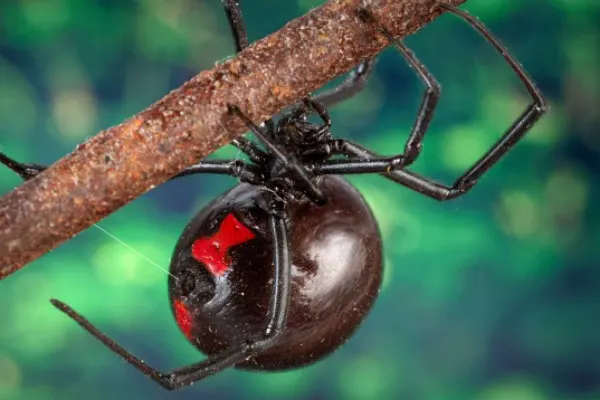
- Scientific name – Latrodectus hasselti
- Size – female: 1 cm; male: 3-4 mm
- Habitat – Throughout Australia
- Toxicity Level – severe symptoms such as discomfort, muscle weakness, nausea, vomiting, sweating, and hypertension
- Estimated no. of Deaths in a Year – 13 deaths over years, but only 1 death since the antivenom was developed
A very powerful neurotoxin is present in its venom, which can produce severe symptoms in humans such as discomfort, muscle weakness, nausea, vomiting, sweating, and elevated heart rate.
Redback spider bites can cause excruciating pain, although they seldom result in death and very few people ever die from them.
26. Black widow spider
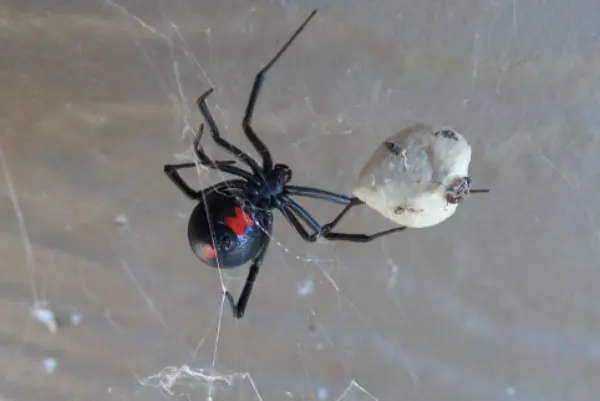
- Scientific name – Latrodectus spp.
- Size – 3 to 13 mm
- Habitat – Throughout Australia
- Toxicity Level – symptoms such as discomfort, muscle rigidity and cramping, burning, and soreness surrounding the bite
- Estimated no. of Deaths in a Year – 4 to 8 deaths each year
After a black widow spider’s bite, diffuse muscle rigidity and cramping, burning and soreness surrounding the bite, discomfort in the abdomen, and nausea are some of the symptoms. Seizures and even death may result from black widow spider venom poisoning in rare and severe cases. In healthy individuals, death rarely happens, though.
Most Poisonous Animals Crawling On Land
27. Eastern Brown Snake

- Scientific name –Pseudonaja textilis
- Size – 1.5 to 2.4 m
- Habitat – woodlands, scrublands, and savannah grasslands
- Toxicity Level – quickest killing and second most toxic of all snake venoms in the world
- Estimated no. of Deaths in a Year – 10 to 20% mortality rate
Its venom is 8,000 times stronger than cyanide and can kill a human in about one hour. Its venom also attacks the central nervous system but this time it slows everything down. And to top it off, the venom has a coagulant that causes the blood in your veins and arteries to clot. Between the two, it’s not a good way to go.
28. Inland Taipan
- Scientific name – Oxyuranus microlepidotus
- Size – 1.83 to 2.74 m
- Habitat – Cracked black-soil floodplains and gibber plains
- Toxicity Level – The venom of one bite is strong enough to kill 100 men
- Estimated no. of Deaths in a Year – no data available
In LD50 testing on mice, the venom of the Inland Taipan is deemed the most lethal of all snake venoms, or among the most poisonous animals, due to its incredible strength.
The venom is very neurotoxic and also has an enzyme called hyaluronidase, which acts as a “spreading factor” to speed up absorption.
Headache, nausea, vomiting, stomach discomfort, collapse, and paralysis are some of the signs and symptoms of envenomation from this species.
29. Eastern Tiger Snake
- Scientific name – Notechis scutatus
- Size – 1.83 to 2.74 m
- Habitat – Cracked black-soil floodplains and gibber plains
- Toxicity Level – The venom of one bite is strong enough to kill 100 men
- Estimated no. of Deaths in a Year – no data available
The Asian tiger snake is the only snake species that is both venomous and poisonous. Not only does it produce toxins for its bite, but it also stores poison it obtains from its toad prey in its skin.
30. King Cobra
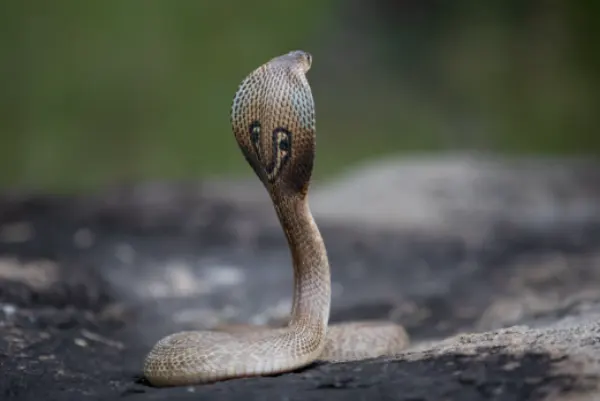
- Scientific name –Ophiophagus hannah
- Size – 10 to 18 feet
- Habitat – favor streams in mangrove swamps, bamboo thickets, close-by agricultural areas, and dense or open forests
- Toxicity Level – The venom of one bite is strong enough to kill 20 men or an elephant
- Estimated no. of Deaths in a Year – fewer than 5 a year
Although its venom is not the strongest among poisonous snakes, it can kill up to 20 humans or an elephant with the amount of neurotoxin they can inject into a single bite. The venom of the king cobra damages the brain’s respiratory centers, leading to cardiac failure and respiratory arrest.
31. Russell’s Viper
- Scientific name – Daboia russelii
- Size – 1.5 m
- Habitat – open, grassy or bushy areas, scrub jungles, forested plantations and farmland
- Toxicity Level – The venom of one bite is strong enough to kill 20 men or an elephant
- Estimated no. of Deaths in a Year – As many as 1000
Within one to fourteen days of the bite, or perhaps even longer, septicemia or renal, pulmonary, or cardiac failure may result in death. One of the deadliest snakes in all of Asia, the Russell’s viper takes hundreds of lives every year.
32. Eastern Diamondback Rattlesnake
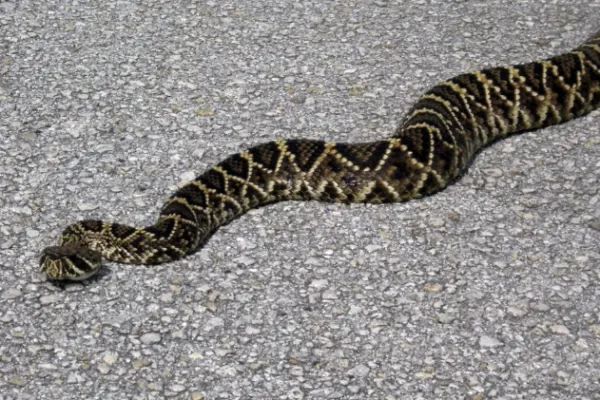
- Scientific name – Crotalus adamanteus
- Size – 3 to 6 feet, max. 8 feet
- Habitat – scrublands, coastal forests, barrier islands, and pine and wiregrass flatwoods
- Toxicity Level – cause major, even fatal envenoming. All cases require urgent assessment and management
- Estimated no. of Deaths in a Year – 10 to 20% fatality rate
They can be lethal to people with their painful, deadly bite and rattle. Hemotoxin, the toxin found in the venom of Eastern diamondback rattlesnakes, cause tissue damage and kills red blood cells.
33. Saw-Scaled/Carpet Viper
- Scientific name – Echis pyramidum
- Size – 0.3 to 0.9 m
- Habitat – arid regions and dry savannas north of the Equator
- Toxicity Level – Fatal, even the smallest and least powerful bite will kill two persons
- Estimated no. of Deaths in a Year – Fatality rate is 2.8%
A single bite from a saw-scaled viper can release up to 70 mg of venom, while an average victim only needs 5 mg to die. Hence, even the smallest and least powerful bite will kill two persons at least because its minimum bite releases 10 mg of the venom.
34. Common krait
- Scientific name – Bungarus caeruleus
- Size – 0.9 to 1.75 m
- Habitat – fields and low scrub jungle to settled areas
- Toxicity Level – causes severe neurotoxic envenoming with life threatening respiratory paralysis
- Estimated no. of Deaths in a Year – mortality rate of 70-80% in untreated cases
When it comes to Asian snakes, the Indian Krait has one of the deadliest venoms. Its venom contains β-bungarotoxin, a presynaptic blocker whose only clinical symptom is paralysis of the muscles.
35. Dubois sea snake
- Scientific name – Aipysurus duboisii
- Size – 80 to 148 cm
- Habitat – tropical northern Australia, Papua New Guinea, and New Caledonia
- Toxicity Level – contains a potent neurotoxin with low that is fatal in even a very low dose
- Estimated no. of Deaths in a Year – No data available
Because sea snake venom contains a strong neurotoxin, envenomation by these reptiles can be lethal if left untreated. Following paralysis of the skeletal muscles and diaphragm, respectively, there may be a risk of drowning or respiratory failure.
Toads/Frogs Among Most Poisonous Animals
36. Golden Dart Frog
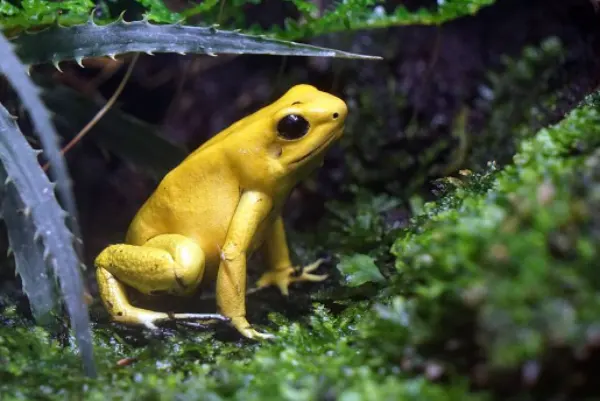
- Scientific name – Phyllobates terribilis
- Size –1.3-5.1 cm
- Habitat – It lives on the forest floor in tropical rainforest
- Toxicity Level – even 1 mm of its poison is enough to kill between 10 and 20 humans
- Estimated no. of Deaths in a Year – No data available
The golden poison frog is one of the most deadly and poisonous animals on the planet. To put its venom’s toxicity into perspective, we estimate that as much poison as two to three table salt grains can kill a human.
37. Cane Toad
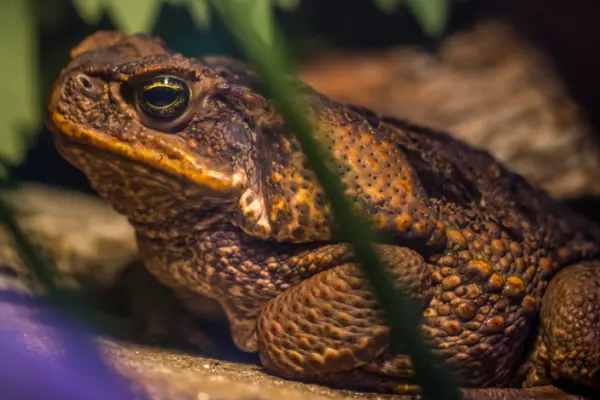
- Scientific name – Rhinella marina
- Size – 6 to 9 inches
- Habitat – Sand dunes, coastal grasslands, rain forests, and mangroves
- Toxicity Level – may cause muscle weakness, rapid heart rate, and vomiting
- Estimated no. of Deaths in a Year –mortality rate was 8.3%
One of the most toxic substances in the world, bufotoxin, is produced by the poison glands of cane toads. Their skin contains an extremely strong poison that is particularly harmful to canines and can kill a wide range of animals. Its venom may result in paralysis, convulsions, an accelerated heartbeat, and profuse salivation.
38. Colorado River/Sonoran Desert toad

- Scientific name – Incilius alvarius
- Size – 3 to 7 inches
- Habitat – desert and semi-arid areas
- Toxicity Level – toxins on their skins are deadly and psychedelic
- Estimated no. of Deaths in a Year – no data available
These toads are very poisonous animals to anyone or anything that comes into contact with them because they have glands on their legs and at the corners of their mouths that release extremely lethal toxins. Because of its psychedelic abilities, 5-MeO-DMT, a chemical that the toad excretes when it feels threatened, is frequently dried into crystals and smoked.
39. Bruno’s Casque-Headed Frog
- Scientific name – Aparasphenodon brunoi
- Size – males: 4.9 to 6.2 cm; females: 5.6 to 8.1 cm
- Habitat – subtropical or tropical moist lowland forests, shrubland, and intermittent freshwater marshes
- Toxicity Level – even 1 gm of its venom would be enough to kill 80 people
- Estimated no. of Deaths in a Year – no data available
In contrast to poison dart frogs, which only release venom through their skin, this species possesses skull spines to inject venom into humans or other animals through headbutting.
Its venom is 25 times more poisonous than that of the fer-de-lance pit vipers. Severe reactions start with extremely small loading doses.
40. Panamanian Golden Frog
- Scientific name – Atelopus zeteki
- Size – males: 3.5 to 4.8 cm; females: 4.5 to 6.3 cm
- Habitat – subtropical or tropical moist lowland forests, shrubland, and intermittent freshwater marshes
- Toxicity Level – One Panamanian golden frog’s skin has enough toxins in it to kill 1,200 mice
- Estimated no. of Deaths in a Year – no data available
Anyone exposed to their water-soluble poison will experience nerve cell damage. This poison serves as the Panamanian golden frogs’ defense against the majority of predators.
The toxin has only been tested on mice because testing on people would be too dangerous. As large doses can be fatal in 20 or 30 minutes.
Other Poisonous Animals
41. Spanish Fly
- Scientific name – Lytta vesicatoria
- Size – 5 mm wide & 20 mm long
- Habitat – leaves of ash, lilac, amur privet, honeysuckle and white willow
- Toxicity Level – Contains cantharidin which causes burning of the mouth, dysphagia, nausea, hematemesis, gross hematuria, and dysuria
- Estimated no. of Deaths in a Year – no data available
The Spanish fly has a toxin cantharidin. Vomiting, diarrhea, nephritis, hematuria, proteinuria, edema, failure of the affected organs, and mortality in humans are just a few of the severe symptoms that its ingestion may cause.
42. Hooded Pitohui
- Scientific name – Pitohui dichrous
- Size – 22 to 23 cm
- Habitat – Rainforest, forest edge, secondary growth forests, and sometimes mangrove forests
- Toxicity Level – contains a very potent neurotoxin that in high quantities, can cause paralysis, cardiac arrest
- Estimated no. of Deaths in a Year – no data available
Hooded pitohui carries the neurotoxin – homobatrachotoxin in its skin and feathers. When humans come into contact with this, they may experience mild numbness and tingling, but smaller animals are far more vulnerable to its severe effects.
It is believed that the poison comes from the poisonous animals or bugs the bird eats. Batrachotoxins is a class of very potent neurotoxin that in high quantities, can cause paralysis, cardiac arrest, and even death.
43. Deathstalker Scorpion
- Scientific name – Leiurus quinquestriatus
- Size – between 1 & 4 inches
- Habitat – desert and scrubland habitats of North Africa to the Middle East
- Toxicity Level – extremely painful sting that can be fatal, especially to children or those with heart conditions
- Estimated no. of Deaths in a Year – no data available
Among all scorpion species, the deathstalker is one of the most dangerous and poisonous animals. Its poison is a potent mix of neurotoxins that requires a little loading dose to be lethal enough.
Though extremely painful, this scorpion’s sting would not typically be deadly to a healthy adult human.
44. Arizona Bark Scorpion
- Scientific name – Centruroides sculpturatus
- Size – max. 6.4 cm
- Habitat – inside the Grand Canyon
- Toxicity Level – its venom causes severe pain, numbness, tingling, and vomiting in adult humans
- Estimated no. of Deaths in a Year – 2 recorded deaths since 1968
The majority of its stings hurt similarly to bee stings that they are uncomfortable, but only severe for people who have a chronic allergy. In adult humans, its venom can produce terrible pain that lasts for 24 to 72 hours, along with numbness, tingling in the affected area, and vomiting.
45. Rough-Skinned Newt
- Scientific name – Centruroides sculpturatus
- Size – 4.33 to 7 inches in total length
- Habitat – throughout the Pacific Northwest
- Toxicity Level – poisonous enough to kill about 25,000 mice
- Estimated no. of Deaths in a Year – 1 death record
The rough-skinned newt is the most poisonous of the three species of poisonous salamanders. They emit a potent scent as a warning, yet their flesh contains enough tetrodotoxin to kill most predators. If the unlucky ones manage to consume the newt despite its dangers, they will go into cardiac arrest and become numb all over, leading to death eventually.
46. Gila monster
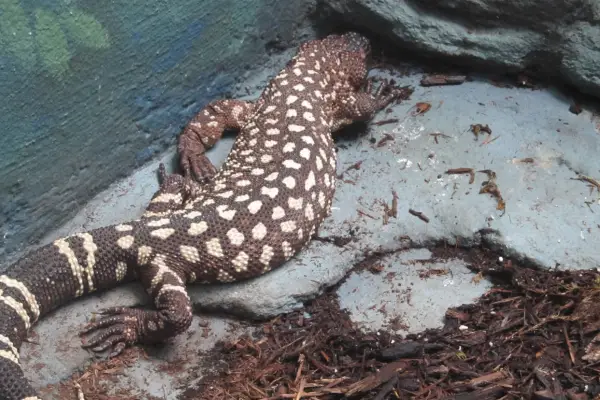
- Scientific name – Heloderma suspectum
- Size – about 22 inches
- Habitat – near narrow streams and in semiarid rocky regions of desert scrub or grasslands
- Toxicity Level – normally not fatal to healthy adult humans
- Estimated no. of Deaths in a Year – 1 death record
The symptoms of a Gila monster bite might include swelling, severe burning pain, vomiting, confusion, and weakness, while the bite is rarely fatal. The sporadic fatalities that have been reported have only happened to individuals who had mishandled the treatment of the bite or were drunk by alcohol.
47. Arabian Fat-Tailed Scorpion
- Scientific name – Androctonus crassicauda
- Size – about 10 cm
- Habitat – semi-arid and arid regions of the Middle East and Africa
- Toxicity Level – venom is very powerful and causes respiratory arrest, heart failure, and shock
- Estimated no. of Deaths in a Year – no data available
This scorpion’s venom is thought to be one of the strongest in the world and has the ability to kill humans. The three main causes of death after its bite are shock, heart failure, and respiratory arrest.
48. Brazillian Yellow Scorpion
- Scientific name – Tityus serrulatus
- Size – between 5 to 7 cm
- Habitat – endemic to Brazil
- Toxicity Level – extremely toxic venom
- Estimated no. of Deaths in a Year – between 2000 to 2012, there were 482,616 accidents and 728 deaths
The venom of the Brazilian yellow scorpion is extremely toxic making it appear on the list of poisonous animals. With the highest number of fatal instances, it is the most hazardous scorpion in South America. It typically causes severe symptoms and is parthenogenetic.
49. Yellow Fat-tail Scorpion
- Scientific name – Androctonus australis
- Size – between 7 to 12 cm
- Habitat – deserts of North Africa and the Middle East
- Toxicity Level – most potent venom of its kind, fast-acting, attacks the CNS causing paralysis and, in some cases, death via respiratory failure
- Estimated no. of Deaths in a Year – 34% fatality after a sting
Because of its relative toxicity and temperament, Androctonus australis is one of the most hazardous scorpions and poisonous animals in the world. It has a very strong venom that takes a number of lives every year.
Its venom, which is the strongest of its kind, mostly has mycotoxins, neurotoxins, cardiotoxins, and hemotoxins. Human deaths typically result from heart and lung failure, and sometimes from shock, organ failure, and cerebral hemorrhage.
50. Spitting Thick-tail Black Scorpion
- Scientific name – Parabuthus transvaalicus
- Size – between 3.5 to 4.3 inches
- Habitat – drier desert and scrubland areas of southern Africa
- Toxicity Level – extremely toxic venom
- Estimated no. of Deaths in a Year – less than 1% of victims have died from its bite
Parabuthus transvaalicus is a significantly dangerous scorpion in medicine. It can both sting and spray its kurtoxin venom which can affect the eyes and respiratory systems of the victim.
The initial venom droplet is called “pre-venom” as it is distinct from the rest of the drops. Parabutoxin, an inhibitor of potassium channels, is also present in its venom.
Conclusion
There you have it, then! Here are 50 amazing, far too venomous/poisonous animals for you to come across and interact with as we wrap up our topic. Check back regularly on our website for further informative content to satiate your intellect.
Also Read:

Anjali Prasad, a B. Pharm. graduate who works as a content writer for HowItSee, is based in Delhi. Except for her, not many people take the typical road from healthcare to writing. Her love of writing stemmed from her involvement in the college literature society and her early journaling at the age of 7. Hence, the love of learning and the spirit of exploration are what drew her to this career. You can find her on common social media like Instagram.
